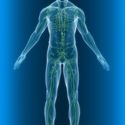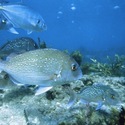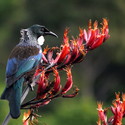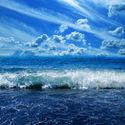David Culliford and Alice Morrison are students at the University of Waikato based at the University’s Coastal Field Centre in Tauranga. During the summer of 2012, they were employed by the Bay of Plenty Regional Council to assist in a broad-scale marine survey of Tauranga Harbour. This is the most extensive quantitative survey of its kind of a New Zealand harbour to date.
The planning for this survey was in place long before the cargo ship Rena was grounded off the Astrolabe Reef in October 2011. Therefore, the survey was not in response to the possibility of an ecological disaster but could well be used as a baseline indicator of the ecological health of the harbour. This could be compared to future studies that might explore possible ecological changes due to incidents such as the Rena shipwreck.
Need for coastal ecosystems baseline data
The Manaaki Taha Moana (MTM) research consortium is dedicated to restoring and enhancing coastal ecosystems and their services of importance to iwi. They recognised the need for better knowledge of the current ecological health of the Tauranga coastline as a basis for restoring and enhancing coastal ecosystems. A baseline was needed to show what organisms existed along the coastline, their habitats and the health of these organisms in relation to their habitats. The information could then be used to identify health problems in the harbour so that restoration plans could be developed. Such ecological data would also be useful when considering consent applications, for example, for building coastal structures or granting permission for mangrove removal. The data could also be used as a baseline for more detailed studies of marine ecosystems within the harbour.
A number of groups who saw the importance of such data collaborated for this survey. These included Manaaki Taha Moana and local iwi, Bay of Plenty Regional Council, The University of Waikato, Massey University, the Cawthron Institute in Nelson and a number of local volunteers.
How the survey was organised and animals collected
The survey took place from Welcome Bay in Tauranga to Athenree in the far northern reaches of the harbour. Samples were taken from 75 intertidal sites at low tide. Each site measured 50 x 10 m and was divided into segments of 10 x 10 m. Ten benthic core samples of 120 mm diameter (Ø) x 130 mm long were taken from within each segment. Photographs of 1 m2 quadrats were also taken from each site to quantify the presence of algae and animals (for example, by counting crab holes) that live on the sediment surface.
David and Alice put the samples into plastic bags and brought them back to the Marine Station at Sulphur Point in Tauranga. Sediment from each sample was then sieved out, and the animals collected were shellfish, worms, anemones, amphipods and other crustaceans. These animals were put into containers and preserved in ethanol. At a later date, the animals from each site were counted and identified. Some of them, such as cockles, were measured as well. Some of the smaller samples, such as worms and amphipods, were sent to the Cawthron Institute in Nelson to be identified by a taxonomist under a microscope.
Scientists at Cawthron also tested an 11th sediment sample from each site for the presence of:
- heavy metals
- pesticides
- total organic carbon (an indicator of decaying matter, bacterial growth and metabolic activities of living organisms or chemicals
- chlorophyll a (an indicator of algal growth)
- nutrients (which may indicate run-off of water from the land).
Measuring sand grain size
The 11th sample was made up from 30 samples measuring 25 mm Ø x 50 mm randomly collected and combined from within a site. It was also from this sample that sand grain size was measured – grain size is an important indicator of what might live in the area (the community structure). Big grains of sand allow more gaps and therefore oxygen into the sediment. Smaller sand grain sizes support lower oxygen content, often creating black mud. Occupants of larger and smaller grain size areas will be different depending on their oxygen needs.
Developing species distribution and community health models
From these results, the MTM team plan to develop species distribution and community health models for the harbour. These will become indicators to monitor improvements or declines in the ecological health of the harbour. Any issues identified through this monitoring would be investigated further. The models can also be used for resource management in the future, such as predicting future species distribution. For example, decreases in nutrient levels due to reducing run-off (due to improved catchment practices) may affect the presence or growth of certain organisms.
An important aspect of this project is that it incorporates local Māori knowledge as well as scientific data. Local Māori are developing a coastal cultural health index for the harbour, which aims to assess and compare trends in the ecosystem of the Bay of Plenty. This information can be coupled with the indicators developed from the scientific research data to produce a robust model. It is the sharing of information between the groups that makes this survey comprehensive.
Nature of science
Increasing pressure to protect and care for our marine resources is motivating scientists to examine the health of marine organisms and their habitats. Different groups and scientists collaborate to get the best information.










